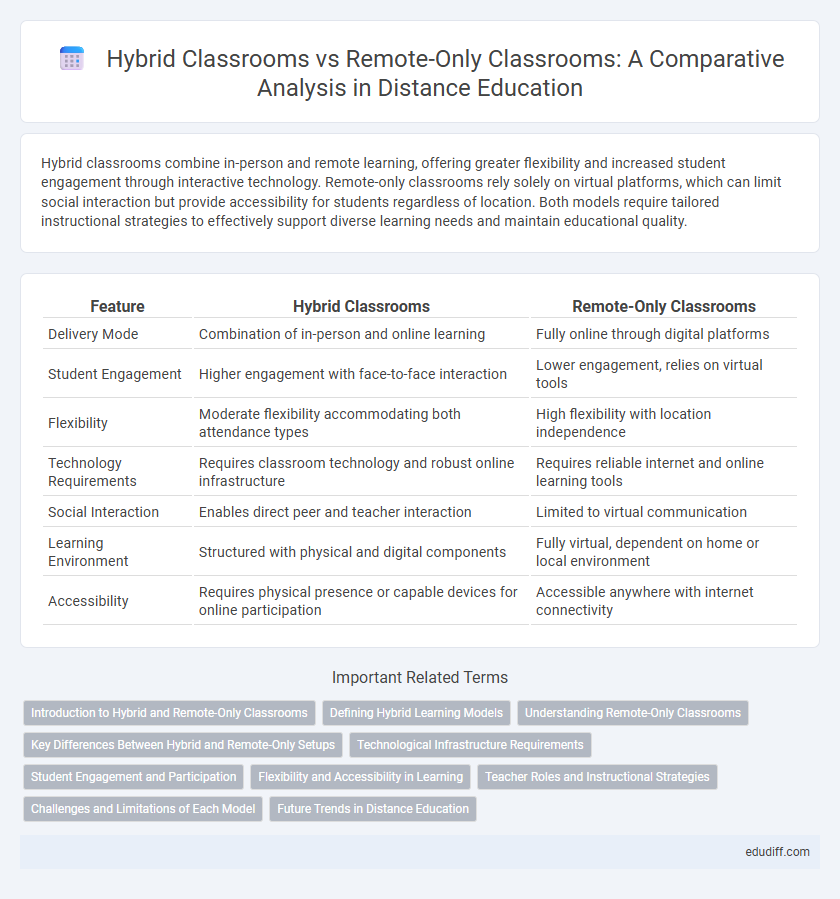Hybrid classrooms combine in-person and remote learning, offering greater flexibility and increased student engagement through interactive technology. Remote-only classrooms rely solely on virtual platforms, which can limit social interaction but provide accessibility for students regardless of location. Both models require tailored instructional strategies to effectively support diverse learning needs and maintain educational quality.
Table of Comparison
| Feature | Hybrid Classrooms | Remote-Only Classrooms |
|---|---|---|
| Delivery Mode | Combination of in-person and online learning | Fully online through digital platforms |
| Student Engagement | Higher engagement with face-to-face interaction | Lower engagement, relies on virtual tools |
| Flexibility | Moderate flexibility accommodating both attendance types | High flexibility with location independence |
| Technology Requirements | Requires classroom technology and robust online infrastructure | Requires reliable internet and online learning tools |
| Social Interaction | Enables direct peer and teacher interaction | Limited to virtual communication |
| Learning Environment | Structured with physical and digital components | Fully virtual, dependent on home or local environment |
| Accessibility | Requires physical presence or capable devices for online participation | Accessible anywhere with internet connectivity |
Introduction to Hybrid and Remote-Only Classrooms
Hybrid classrooms combine in-person and online learning, allowing students to attend classes physically or remotely, enhancing flexibility and engagement. Remote-only classrooms rely exclusively on virtual platforms, enabling full access to education without geographic constraints but requiring strong self-discipline and technological resources. Both models leverage digital tools to facilitate communication, collaboration, and access to educational content across diverse learning environments.
Defining Hybrid Learning Models
Hybrid learning models combine in-person and remote instruction, allowing students to participate both on campus and online, enhancing flexibility and accommodating diverse learning needs. This approach integrates synchronous and asynchronous elements, utilizing digital platforms and classroom technology to ensure seamless interaction between educators and learners. By blending physical presence with virtual engagement, hybrid classrooms offer a dynamic educational experience that supports personalized pacing and real-time collaboration.
Understanding Remote-Only Classrooms
Remote-only classrooms rely entirely on digital platforms, enabling students to access instructional materials and participate in lessons from any location. These environments demand strong internet connectivity and self-discipline for effective learning, often utilizing video conferencing, interactive tools, and asynchronous content. The absence of physical presence poses challenges in maintaining engagement and fostering collaboration, making technological proficiency and clear communication vital for success.
Key Differences Between Hybrid and Remote-Only Setups
Hybrid classrooms combine in-person and online learning environments, enabling real-time interaction between teachers and students both on-site and remotely. Remote-only classrooms rely entirely on digital platforms, focusing on virtual engagement without physical presence. Key differences include the level of direct interaction, technology requirements, and adaptability to diverse student needs within the learning environment.
Technological Infrastructure Requirements
Hybrid classrooms demand robust technological infrastructure, including high-speed internet, advanced audiovisual equipment, and interactive platforms to seamlessly integrate in-person and remote learners. Remote-only classrooms rely heavily on stable broadband, cloud-based learning management systems, and versatile communication tools to facilitate uninterrupted virtual instruction. Both models require consistent technical support and cybersecurity measures to ensure effective and secure student engagement.
Student Engagement and Participation
Hybrid classrooms foster higher student engagement and participation by combining face-to-face interaction with digital tools, allowing real-time collaboration and instant feedback. Remote-only classrooms often face challenges with student distractions and limited social presence, which can reduce active participation and motivation. Integrating synchronous video sessions and interactive platforms in hybrid models significantly enhances student involvement compared to fully remote learning environments.
Flexibility and Accessibility in Learning
Hybrid classrooms provide enhanced flexibility by allowing students to participate both in-person and online, accommodating diverse schedules and learning preferences. Remote-only classrooms offer accessibility by enabling learners from any geographical location to join without commuting, removing physical barriers to education. Combining these models can optimize learning experiences by addressing varied needs in flexibility and accessibility.
Teacher Roles and Instructional Strategies
Hybrid classrooms require teachers to adeptly balance simultaneous in-person and online interactions, utilizing blended instructional strategies such as synchronous discussions and asynchronous assignments to engage all students. Remote-only classrooms demand educators to prioritize digital communication skills and leverage interactive technologies like video conferencing and learning management systems to maintain student motivation and participation. Effective teacher roles in both settings emphasize adaptability, with hybrid models focusing on real-time dual engagement and remote-only models centering on fostering independent learning through structured virtual environments.
Challenges and Limitations of Each Model
Hybrid classrooms face challenges such as technological disparities and difficulty maintaining student engagement equally across in-person and virtual participants. Remote-only classrooms struggle with limited social interaction, increased distractions, and reliance on stable internet connections, which can hinder learning outcomes. Both models require tailored strategies to address issues like digital equity and effective communication to optimize educational experiences.
Future Trends in Distance Education
Hybrid classrooms integrate in-person and remote learning environments, leveraging AI-driven platforms and adaptive technologies to enhance personalized education. Future trends in distance education emphasize immersive virtual reality experiences and seamless connectivity to facilitate real-time collaboration irrespective of geographic location. Data analytics and augmented reality tools are expected to redefine engagement metrics and expand accessibility, supporting diverse learning preferences and needs.
Hybrid Classrooms vs Remote-Only Classrooms Infographic

 edudiff.com
edudiff.com